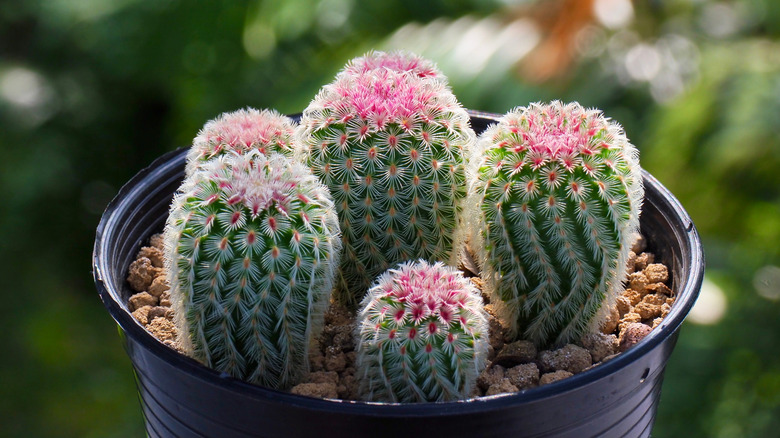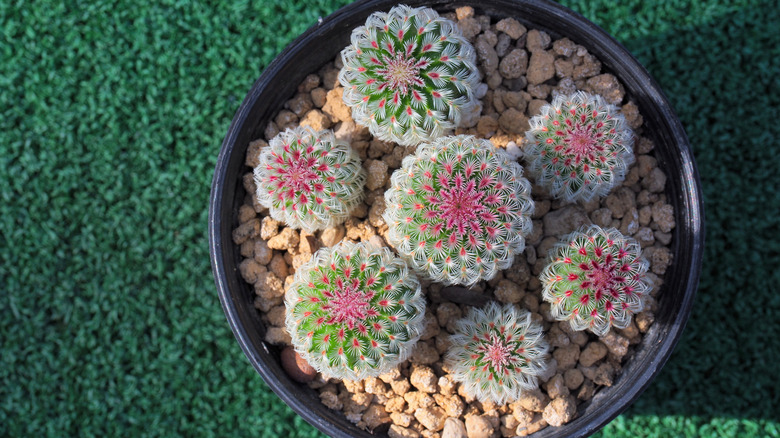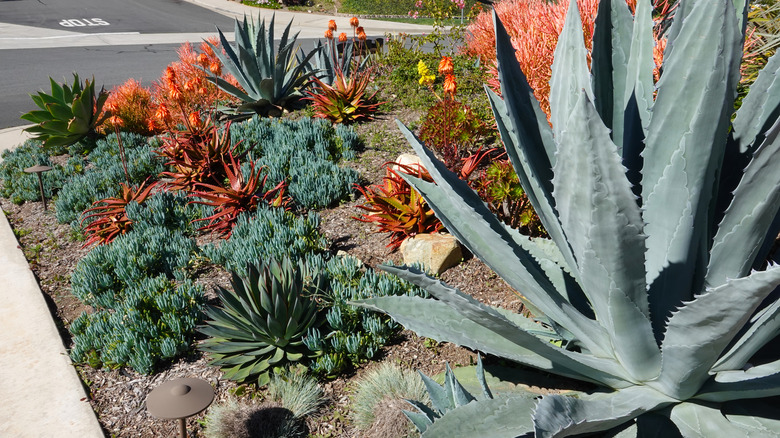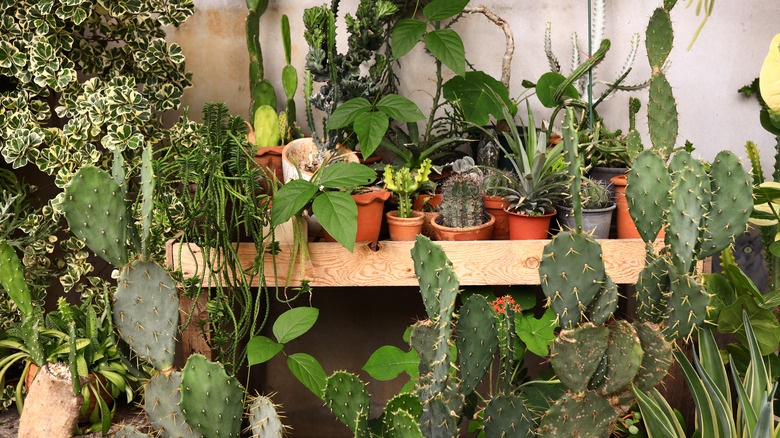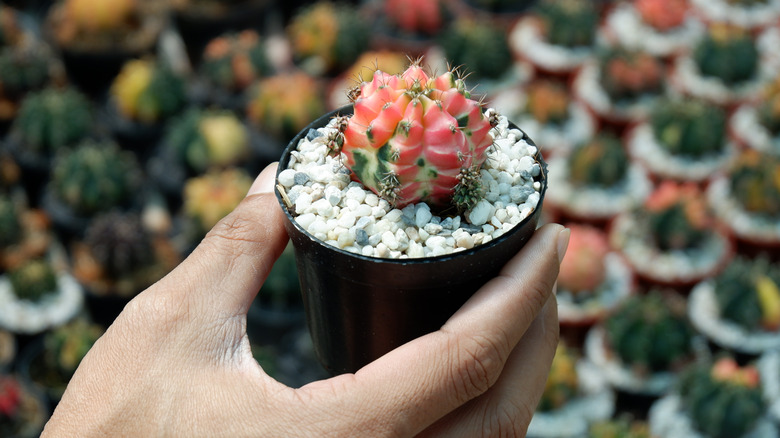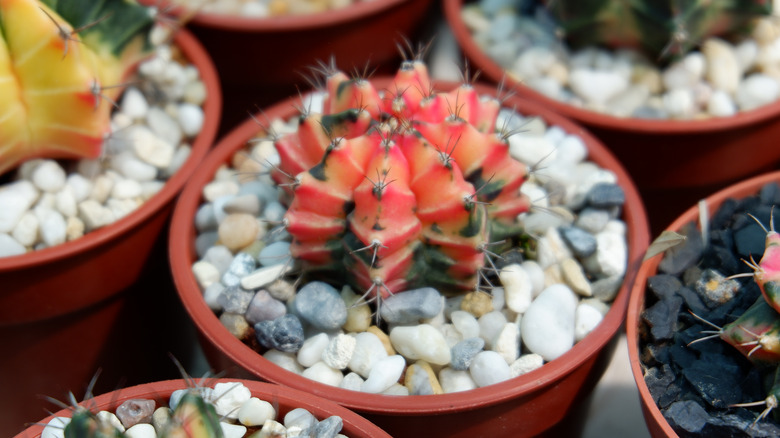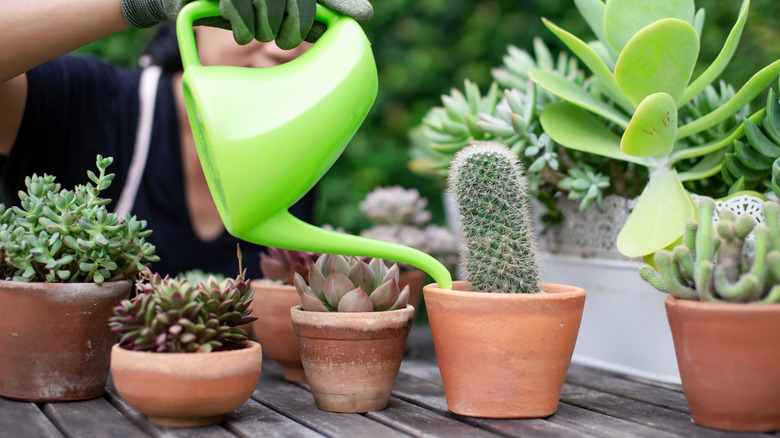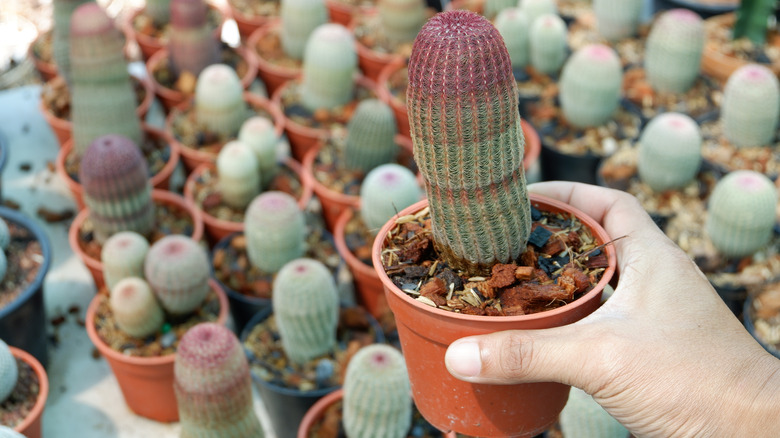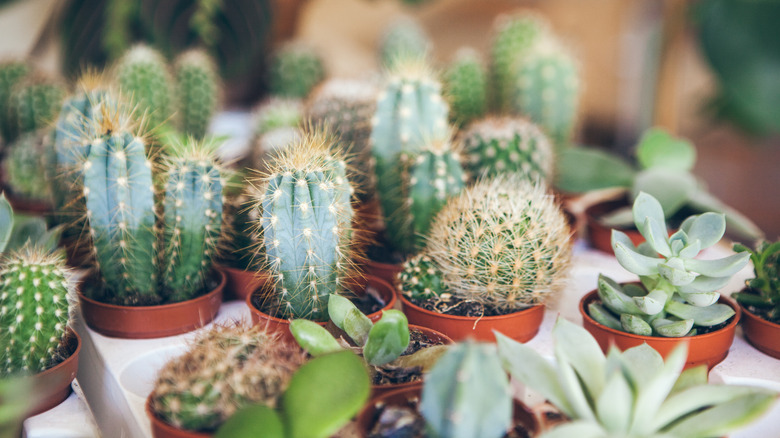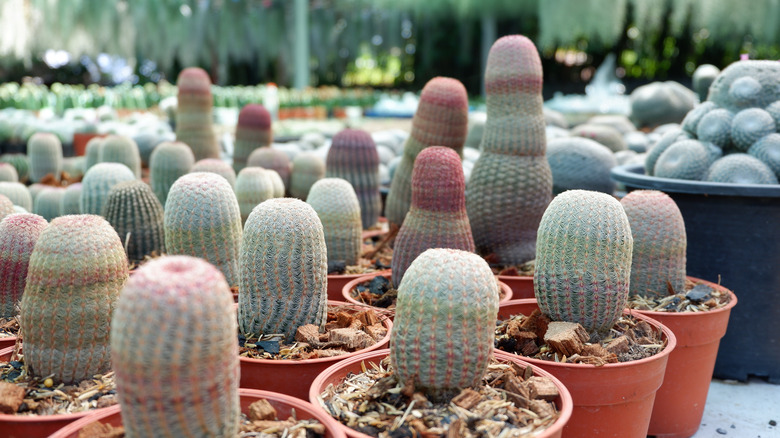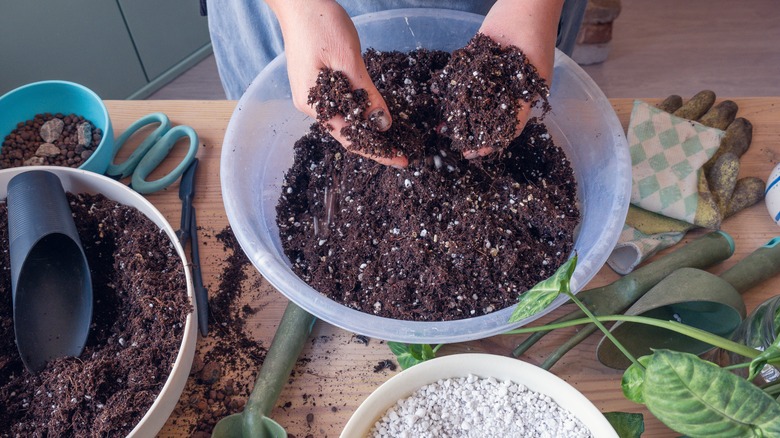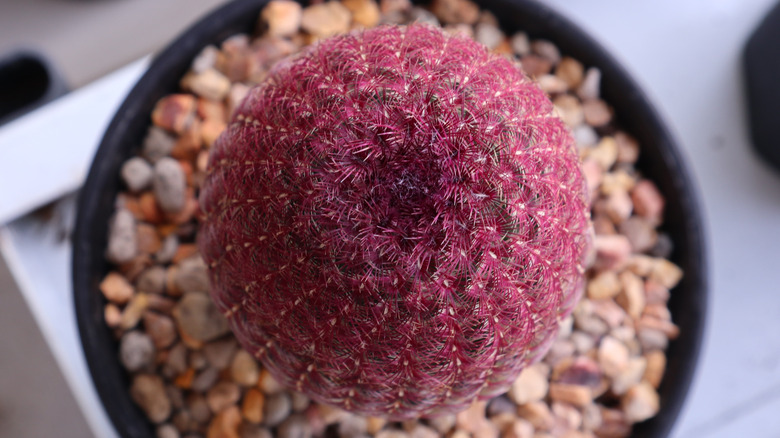How To Care For A Rainbow Hedgehog Cactus
The rainbow hedgehog cactus (Echinocereus rigidissimus), also known as the Arizona rainbow cactus, is an ideal plant for experienced cactuses gardeners and beginners alike. It is a globular cactus, growing in small, round masses with small thorns. The plant gets its common name from the light pink coloration around the top. If provided the proper growing conditions, it can also bloom pink or purple flowers during the summer, according to Lady Bird Johnson Wildflower Center.
The cactus grows natively in the arid south. It's found in New Mexico, Arizona, and neighboring states in Mexico like Sonora and Chihuahua. The plant can only grow up to 1 foot in height, becoming more cylindrical the taller it gets. It is 1½ to 3½ inches thick at its most mature, and flowers tend to reach 2½ to 3 inches in length. This feature makes them ideal indoor houseplants or cute accents for outdoor rock, and succulent gardens.
The rainbow hedgehog cactus is non-toxic to humans and pets, including cats, dogs, birds, and livestock (via Gardeners World). They also attract beneficial insects like bees and butterflies. While it does have small thorns, the spines form cushions as the plant ages. If you handle the plant carefully or with gloves, it won't harm you. Here is everything you need to know about caring for a rainbow hedgehog cactus.
How to use in a garden
One of the best ways to display a beautiful cactus like the rainbow hedgehog is to incorporate it as part of your landscaping or outdoor decoration. For those in hotter areas, including USDA hardiness zones 9a through 11b, you can grow this cactus outdoors year-round, per World of Succulents. For those who live in colder climates, you can still plant them outdoors — you'll need to dig them up before each frost or plant them in containers that can go inside.
Rainbow hedgehog cactuses prefer temperatures above 70 degrees Fahrenheit, but they can survive down to as low as 10 degrees (via Tula House). Err on the side of caution, but putting your cactus indoors later in the winter typically won't result in premature death. They also prefer lower humidity, being native to arid, desert-like climates. Finally, they don't need water that much, preferring drier soils. If you live in a more moist area, add plenty of sand or grit to your soil.
The possibilities for landscaping and decorating with your rainbow hedgehog cactus are vast. These plants lend themselves best to cactus gardens, offering a bright pop of color amidst a sea of green. You can grow a cactus garden in soil or containers, and they look great with accents like stones or rocks, colored gravel, or mixed with other plants with similar growing conditions.
Creating an outdoor cactus garden
If you live in a desert climate, which includes southern and southwest regions of the United States, you can grow a perennial cactus and succulent garden. You can attempt to grow an in-ground cactus garden in colder and moister climates, but the plants will likely die off over the winter.
For those who live in desert climates that sustain the rainbow hedgehog cactus year round, your first step is to figure out where you want it to go. Cactus Info recommends planting your cactus garden on the top of a hill since water will easily flow down and help prevent root rot. You should also ensure the soil is sandy and well-drained or if you have to incorporate sand into the soil. Alternatively, you can dig up anywhere from 6 to 12 inches of dirt and fill it with cactus soil. Finally, the spot should receive plenty of unfiltered, direct sun.
To avoid weed growth, which can easily damage your cactuses' sensitive root systems, consider using plastic to create a border around your garden and hide it with gardening stone, tile, or rocks. Choose a variety of desert cactuses and succulents and plant them intermittently. You can plant smaller ones, like the rainbow hedgehog cactus, in dense clusters or dotted between large statement plants, but they will likely look awkward if alone.
Potential companion plants
Not all cactuses and succulents are suitable for the dryness of desert regions, but plenty of them are. When planted together in a garden bed or used in landscaping, the result is a stunning array of lush greenery, with hints of color unique to the environment. There are endless ways to plan a cactus garden and even more plants to choose from, but starting with a few statement plants is a good idea.
Some statement cactuses suitable for desert environments include the giant prickly pear (opuntia robusta), spruce cones (tephrocactus articulatus 'inermis'), cardon grande (echinopsis terscheckii), or the golden barrel (echinocactus grusonii), according to Arizona Municipal Water Users Association (AMWUA). For less spiky foliage, some stunning succulents include most agave and yucca plants, as well as bear grass (nolina microcarpa) and desert spoon (dasylirion wheeleri) (via AMWAU). Keep cactuses and succulents separate from other plants that may need more water. Decorate the exterior border of your garden with some beautiful desert shrubs, including bee brush (aloysia gratissima), Chihuahan sage (leucophyllum laevigatum), or a firecracker bush (hamelia patens) (via AMWAU).
How to grow a rainbow hedgehog cactus
Rainbow hedgehog cactuses are a little pricier than the average cactus due to their unique and beautiful variegation. They may be a little hard to find at most garden centers or plant stores, so if you want your hands on one soon, your best bet is an online retailer. Succulents Box sells a 4-inch plant for $18.75 and a 6-inch for $35.05, listing it as a rare plant.
However, buying a new plant isn't the only way to get ahold of this cactus. If you have a friend who has one, or you already have your own and want another, you can propagate the plant. Propagation is a little more complicated for cactuses than the average houseplant, but it isn't impossible. You can't simply cut off a long leaf and stick it in a jar of water, especially with globular cactuses.
To propagate a rainbow hedgehog cactus, you'll need to look for an offshoot or pup (via North Dakota State University). These small cactuses grow off the main cactus. You can dig it up and separate it from the main plant. Let the cutting dry out, scab over for a few days, and then pot it in pumice to form roots. After a few weeks, you can transfer it to a cactus potting mix or make your own mixture with one part soil, one part sand, and one part pumice.
Growing from seed
If propagation doesn't pan out for you, you can also grow cactuses from seed. This process will be more tedious than propagation, but watching the plant grow from seed to full maturity is incredibly rewarding. You likely won't find cactus seeds at most garden centers or stores, so look for online retailers. UnusualSeeds sells 10 rainbow hedgehog cactus seeds for $3.95, which is much more cost-efficient than buying a new plant.
Once you get your cactus seeds, you'll need a small terracotta or plastic pot and a well-draining and gritty compost, per Gardeners World. Fill the pot with compost almost to the top, and thinly sprinkle seeds across the surface. Cover the seeds and compost with vermiculite and top the pot with a clear plastic bag — this will help with moisture retention. Leave the plastic-covered pot on a warm and sunny windowsill. After a few weeks, the seeds will start to germinate, at which point you can take the plastic off. Water only when the soil is dry but spray with water frequently to keep the surface moist. Eventually, the seeds will grow into small cactus heads. At this point, you can gently scoop out the baby plant, being careful not to break the fragile roots. Transplant each plant into its own individual pot filled with cactus soil and add some gravel to the surface.
Water and humidity needs
Home gardeners have different opinions about cactus care. One camp finds it incredibly easy, and the other finds it very difficult. The trick to plant care in general, especially for cactuses, is to replicate their native growing conditions as closely as possible. This tip usually means watering your plants less than expected.
The rainbow hedgehog cactus naturally grows in very dry, incredibly arid environments in rocky mountains around the dry southern regions of the country, notes Lady Bird Johnson Wildlife Center. Be careful not to overwater your cactus, as it can get root rot (via Tula House). Always err on the side of underwatering, as cactuses store moisture in their leaves that will help them get through long periods of drought. If you're concerned about overwatering, you can get a moisture meter for the plant. Excess humidity can also contribute to stem and root rot, so keep this cactus away from humidifiers in drier areas of your home.
Sun, temperature, and fertilizer requirements
When it comes to light, the rainbow hedgehog cactus likes as much as possible. According to Tula House, the absolute minimum for these plants are five hours of full, direct sun. Ideally, though, they'd get a total of eight hours. A south-facing window is the best, but west-facing windows also work. The afternoon and evening sun will be warmer than the morning, which is ideal since these plants prefer being warm. They can survive lower temperatures, but the higher, the better. Above 70 degrees Fahrenheit is ideal.
The rainbow hedgehog cactus is beautiful in all seasons, but it can also flower in the summer in the right circumstances. It is unlikely to flower indoors, but there are things you can do to encourage it. For example, providing it with lots of light and warmth will help, and water less in the winter. You can also use fertilizer with a cactus-specific mixture monthly during the spring and summer, which will help the plant grow healthier, stronger, and quicker and encourage beautiful blooms. Organic fertilizer with humic acids, low amount of NPC, and high phosphorous content is typically best for cactuses (via CactusWay). Organic varieties are best because the nutrients remain in the soil for longer.
Rainbow hedgehog cactus varieties
The rainbow hedgehog cactus is one of many in the Echinocereus genus. This genus is well loved by many cactus gardeners, as they provide uniquely gorgeous flowers compared to other cactus genera, according to Cacti Guide. They all share similar physical characteristics, including being smaller and globular/cylindrical. There are over a hundred cactuses in the genus, including species, varieties, and hybrids.
Here are just a few of the many Echinocereus (via Succulent Alley):
- Echinocereus reichenbachii: The lace hedgehog cactus, as it's also known, is a cylindrical variety that has a lace-patterned spine and sports beautiful, bright purple flowers.
- Echinocereus pectinatus: Also referred to as the rainbow cactus due to its spine, which features shades of yellow, pink, and brown. The flower it produces turns into a sweet, sugary fruit when done blooming.
- Echinocereus arizonicus subsp. matudae: This variety is one of the largest, growing up to 50 centimeters in height. It has much larger spikes than most of its genus and bears beautiful red flowers in the summer.
- Echinocereus chloranthus: This species is unique for its deep flowers in earthy shades of pink and brown. It grows more cylindrical than globular, and the flowers grow from the center up as opposed to the top.
- Echinocereus cinerascens: This cactus grows beautiful pink and purple flowers up to 12 centimeters in diameter. The flowers turn into a fruit that is said to taste like strawberries.
- Echinocereus armatus: This species is known for its pretty in pink flowers that grow quite large. The light brown spines are feature dark tips.
How to repot the rainbow hedgehog cactus
No matter how mature or slow growing it is, every plant needs repotting eventually, whether to give it more growing space, a roomier pot, or refresh the soil and supply the plant with more nutrients. Luckily, the rainbow hedgehog cactus doesn't need to be repotted that frequently, only every other year, according to World of Succulents. If the plant is outgrowing its pot, do so earlier.
If your plant does need a new pot, don't go too far up in size. An inch or so is perfect. Aim for terracotta or clay pots to absorb excess water and provide better drainage than other materials. Begin by uprooting the cactus from its current pot, avoiding the prickly spine — wear gloves if you need to. Break up the soil by its roots, careful not to damage the root system. At this point, you can assess it for any signs of damage or disease and remove offshoots or pups. Add some well-draining, sandy soil, or one formulated for cactuses, to the pot. Add your cactus, and try to get it to sit at the same level as before. Once the plant is in place, fill the rest of the way with soil. Consider topping it with gravel to provide even more drainage.
Make your own cactus soil mix
While you can always purchase cactus soil mixtures, consider making your own to cut down on costs. If you're a serious home gardener with lots of plants, buying the necessary supplies in bulk and making your own mixtures can be very cost-efficient. It's also a great way to tailor the soil to your plant's needs and become more well-versed in gardening science. For a plant as stunning and pricey as the rainbow hedgehog cactus, it's a good idea to create a tailor-made soil mix.
According to CactusWay, cactus soil needs to be well-draining, as similar as possible to the sandy desert conditions it grows in. Not all cactuses come from the desert, yet another reason making your own mix is a good idea. To make your soil mixture, gather something to mix and store the soil in and a measuring cup of your choice. You may also want gloves and a towel. You'll also need fine sand, perlite, and grit — all contribute to excellent drainage — and garden soil.
To create your mixture, combine three parts soil, three parts sand and grit, and two parts perlite. Mix thoroughly, and then sterilize your soil in batches using a bain-marie — this will prevent your cactus from getting a bacterial infection. Let cool and store in an airtight container.
How to overwinter the rainbow hedgehog cactus
Overwintering is an important process for most plants, especially those from tropical or desert environments. Cactuses, including the rainbow hedgehog cactus, are even more vulnerable to cold winters, making the process all the more essential. Getting cactuses to flower is slightly challenging, but properly overwintering them can encourage blooming.
As The Seattle Times points out, cactuses need to be kept in colder conditions over the winter to stimulate their blooming cycle — roughly 40 to 55 degrees Fahrenheit. The biggest concern with cactuses isn't even temperatures, though. As stated earlier, rainbow hedgehog cactuses can survive in temperatures as cool as 10 degrees. The primary concern for any cactus is the moisture level. Even if your plant is slightly wet before overwintering, it will likely develop root rot.
Fully grown cactuses should be in a cold and dry room, like a garage that receives some light (via Desert Plants of Avalon). Once the weather warms back up, bring them into a warmer room or outside and begin watering again. However, don't overwinter younger plants and propagations. Instead, seedlings should be kept warm and moist, and propagations should be kept inside with regular temperatures and watering schedules.
